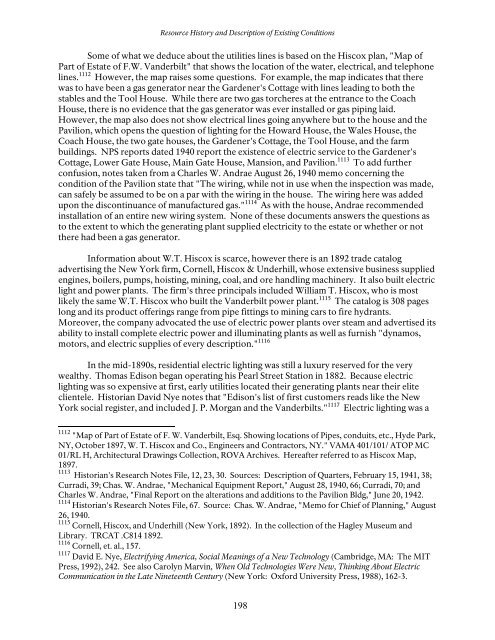National Park Service U.S. Department of the Interior
National Park Service U.S. Department of the Interior
National Park Service U.S. Department of the Interior
You also want an ePaper? Increase the reach of your titles
YUMPU automatically turns print PDFs into web optimized ePapers that Google loves.
Resource History and Description <strong>of</strong> Existing Conditions<br />
Some <strong>of</strong> what we deduce about <strong>the</strong> utilities lines is based on <strong>the</strong> Hiscox plan, "Map <strong>of</strong><br />
Part <strong>of</strong> Estate <strong>of</strong> F.W. Vanderbilt" that shows <strong>the</strong> location <strong>of</strong> <strong>the</strong> water, electrical, and telephone<br />
lines. 1112 However, <strong>the</strong> map raises some questions. For example, <strong>the</strong> map indicates that <strong>the</strong>re<br />
was to have been a gas generator near <strong>the</strong> Gardener's Cottage with lines leading to both <strong>the</strong><br />
stables and <strong>the</strong> Tool House. While <strong>the</strong>re are two gas torcheres at <strong>the</strong> entrance to <strong>the</strong> Coach<br />
House, <strong>the</strong>re is no evidence that <strong>the</strong> gas generator was ever installed or gas piping laid.<br />
However, <strong>the</strong> map also does not show electrical lines going anywhere but to <strong>the</strong> house and <strong>the</strong><br />
Pavilion, which opens <strong>the</strong> question <strong>of</strong> lighting for <strong>the</strong> Howard House, <strong>the</strong> Wales House, <strong>the</strong><br />
Coach House, <strong>the</strong> two gate houses, <strong>the</strong> Gardener's Cottage, <strong>the</strong> Tool House, and <strong>the</strong> farm<br />
buildings. NPS reports dated 1940 report <strong>the</strong> existence <strong>of</strong> electric service to <strong>the</strong> Gardener's<br />
Cottage, Lower Gate House, Main Gate House, Mansion, and Pavilion. 1113 To add fur<strong>the</strong>r<br />
confusion, notes taken from a Charles W. Andrae August 26, 1940 memo concerning <strong>the</strong><br />
condition <strong>of</strong> <strong>the</strong> Pavilion state that "The wiring, while not in use when <strong>the</strong> inspection was made,<br />
can safely be assumed to be on a par with <strong>the</strong> wiring in <strong>the</strong> house. The wiring here was added<br />
upon <strong>the</strong> discontinuance <strong>of</strong> manufactured gas." 1114 As with <strong>the</strong> house, Andrae recommended<br />
installation <strong>of</strong> an entire new wiring system. None <strong>of</strong> <strong>the</strong>se documents answers <strong>the</strong> questions as<br />
to <strong>the</strong> extent to which <strong>the</strong> generating plant supplied electricity to <strong>the</strong> estate or whe<strong>the</strong>r or not<br />
<strong>the</strong>re had been a gas generator.<br />
Information about W.T. Hiscox is scarce, however <strong>the</strong>re is an 1892 trade catalog<br />
advertising <strong>the</strong> New York firm, Cornell, Hiscox & Underhill, whose extensive business supplied<br />
engines, boilers, pumps, hoisting, mining, coal, and ore handling machinery. It also built electric<br />
light and power plants. The firm's three principals included William T. Hiscox, who is most<br />
likely <strong>the</strong> same W.T. Hiscox who built <strong>the</strong> Vanderbilt power plant. 1115 The catalog is 308 pages<br />
long and its product <strong>of</strong>ferings range from pipe fittings to mining cars to fire hydrants.<br />
Moreover, <strong>the</strong> company advocated <strong>the</strong> use <strong>of</strong> electric power plants over steam and advertised its<br />
ability to install complete electric power and illuminating plants as well as furnish "dynamos,<br />
motors, and electric supplies <strong>of</strong> every description." 1116<br />
In <strong>the</strong> mid-1890s, residential electric lighting was still a luxury reserved for <strong>the</strong> very<br />
wealthy. Thomas Edison began operating his Pearl Street Station in 1882. Because electric<br />
lighting was so expensive at first, early utilities located <strong>the</strong>ir generating plants near <strong>the</strong>ir elite<br />
clientele. Historian David Nye notes that "Edison's list <strong>of</strong> first customers reads like <strong>the</strong> New<br />
York social register, and included J. P. Morgan and <strong>the</strong> Vanderbilts." 1117 Electric lighting was a<br />
1112 "Map <strong>of</strong> Part <strong>of</strong> Estate <strong>of</strong> F. W. Vanderbilt, Esq. Showing locations <strong>of</strong> Pipes, conduits, etc., Hyde <strong>Park</strong>,<br />
NY, October 1897, W. T. Hiscox and Co., Engineers and Contractors, NY." VAMA 401/101/ ATOP MC<br />
01/RL H, Architectural Drawings Collection, ROVA Archives. Hereafter referred to as Hiscox Map,<br />
1897.<br />
1113 Historian's Research Notes File, 12, 23, 30. Sources: Description <strong>of</strong> Quarters, February 15, 1941, 38;<br />
Curradi, 39; Chas. W. Andrae, "Mechanical Equipment Report," August 28, 1940, 66; Curradi, 70; and<br />
Charles W. Andrae, "Final Report on <strong>the</strong> alterations and additions to <strong>the</strong> Pavilion Bldg," June 20, 1942.<br />
1114 Historian's Research Notes File, 67. Source: Chas. W. Andrae, "Memo for Chief <strong>of</strong> Planning," August<br />
26, 1940.<br />
1115 Cornell, Hiscox, and Underhill (New York, 1892). In <strong>the</strong> collection <strong>of</strong> <strong>the</strong> Hagley Museum and<br />
Library. TRCAT .C814 1892.<br />
1116 Cornell, et. al., 157.<br />
1117 David E. Nye, Electrifying America, Social Meanings <strong>of</strong> a New Technology (Cambridge, MA: The MIT<br />
Press, 1992), 242. See also Carolyn Marvin, When Old Technologies Were New, Thinking About Electric<br />
Communication in <strong>the</strong> Late Nineteenth Century (New York: Oxford University Press, 1988), 162-3.<br />
198

















